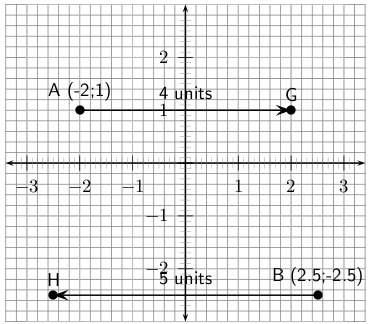| << Chapter < Page | Chapter >> Page > |
In this section you will learn about how the co-ordinates of a point change when the point is moved horizontally and vertically on the Cartesian plane. You will also learn about what happens to the co-ordinates of a point when it is reflected on the -axis, -axis and the line .
When something is moved in a straight line, we say that it is translated . What happens to the co-ordinates of a point that is translated horizontally or vertically?
Complete the table, by filling in the co-ordinates of the points shown in the figure.

| Point | co-ordinate | co-ordinate |
| A | ||
| B | ||
| C | ||
| D | ||
| E | ||
| F | ||
| G |
What do you notice about the co-ordinates? What do you notice about the co-ordinates? What would happen to the co-ordinates of point A, if it was moved to the position of point G?
When a point is moved vertically up or down on the Cartesian plane, the co-ordinate of the point remains the same, but the co-ordinate changes by the amount that the point was moved up or down.
For example, in [link] Point A is moved 4 units upwards to the position marked by G. The new co-ordinate of point A is the same ( =1), but the new co-ordinate is shifted in the positive direction 4 units and becomes =-2 +4 =2. The new co-ordinates of point A are therefore G(1;2). Similarly, for point B that is moved downwards by 5 units, the co-ordinate is the same ( ), but the co-ordinate is shifted in the negative -direction by 5 units. The new co-ordinate is therefore =2,5 -5 =-2,5.

Complete the table, by filling in the co-ordinates of the points shown in the figure.

| Point | co-ordinate | co-ordinate |
| A | ||
| B | ||
| C | ||
| D | ||
| E | ||
| F | ||
| G |
What do you notice about the co-ordinates? What do you notice about the co-ordinates?
What would happen to the co-ordinates of point A, if it was moved to the position of point G?
When a point is moved horizontally left or right on the Cartesian plane, the co-ordinate of the point remains the same, but the co-ordinate changes by the amount that the point was moved left or right.
For example, in [link] Point A is moved 4 units right to the position marked by G. The new co-ordinate of point A is the same ( =1), but the new co-ordinate is shifted in the positive direction 4 units and becomes =-2 +4 =2. The new co-ordinate of point A at G is therefore (2;1). Similarly, for point B that is moved left by 5 units, the co-ordinate is the same ( ), but the co-ordinate is shifted in the negative -direction by 5 units. The new co-ordinate is therefore =2,5 -5 =-2,5. The new co-ordinates of point B at H is therefore (-2,5;1).


Notification Switch
Would you like to follow the 'Siyavula textbooks: grade 10 maths [ncs]' conversation and receive update notifications?